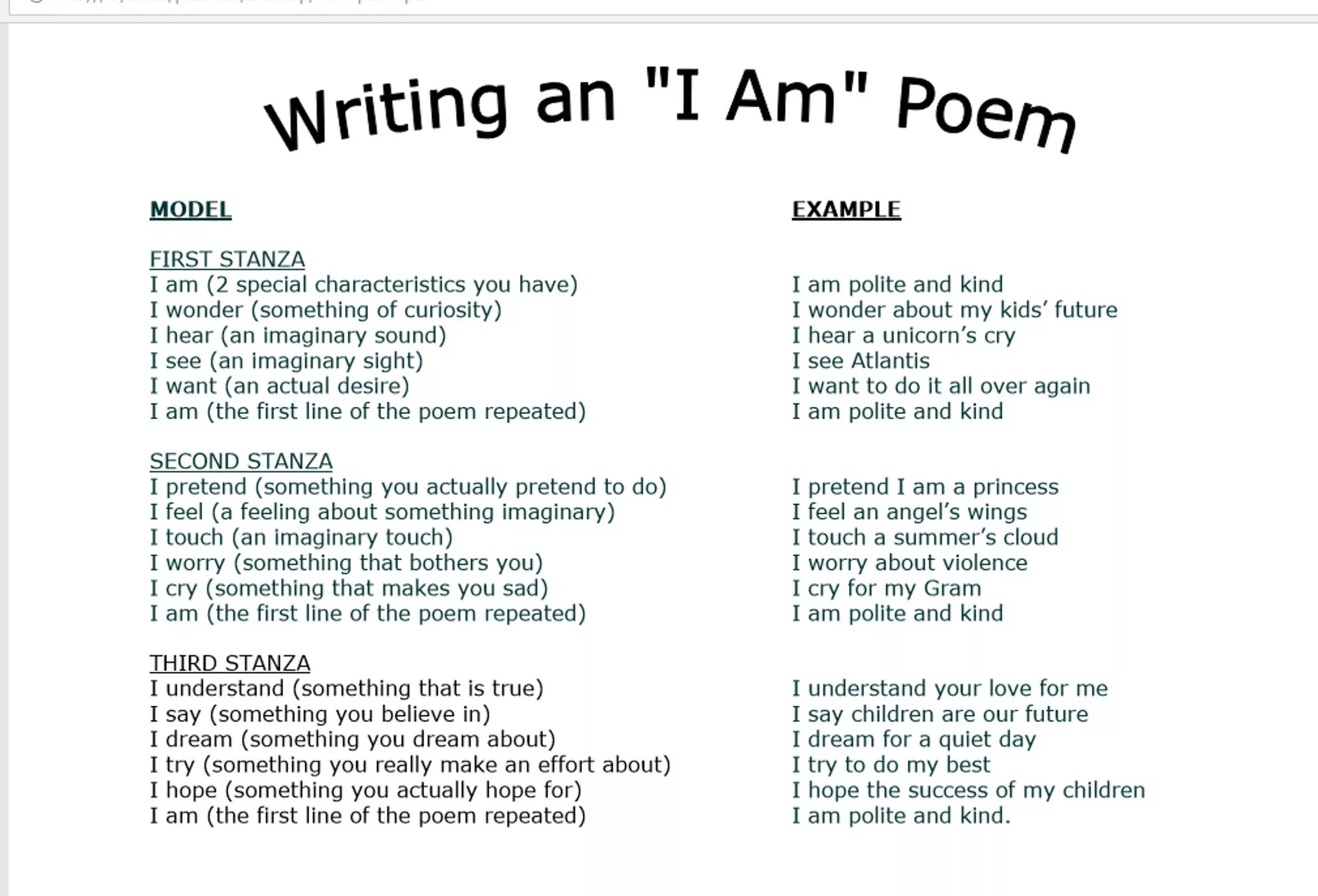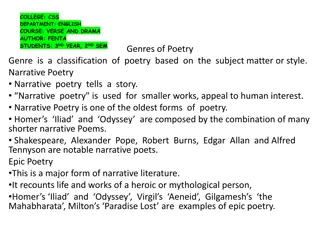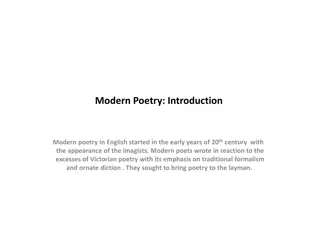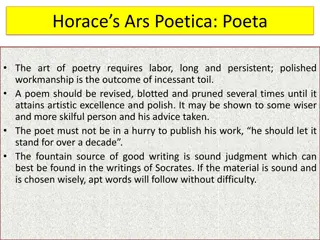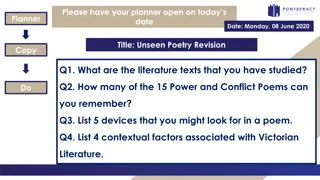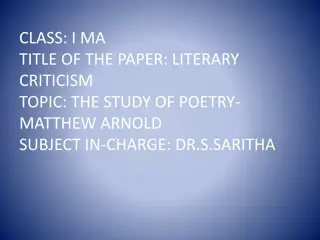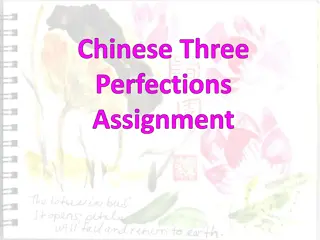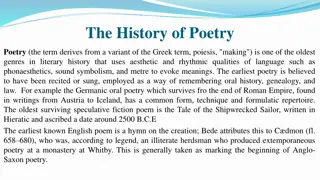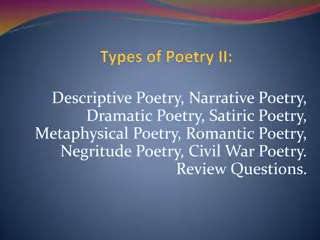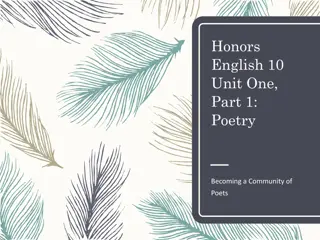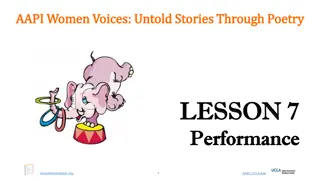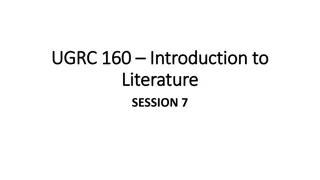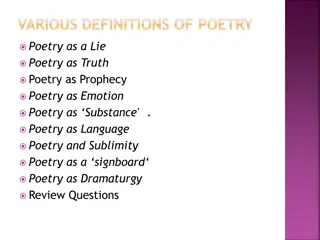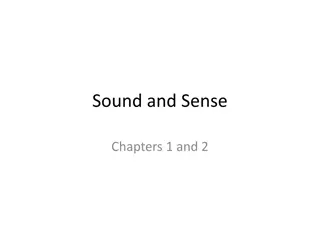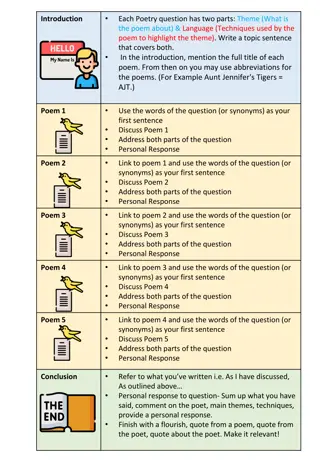Crafting Poetry - Tips and Techniques
Delve into the art of poetry with tips on creating I Am poems, acrostic poetry, and following essential rules for good poetry writing. Explore the steps to craft beautiful verses effortlessly, all while immersing yourself in the world of poetic expression.
Download Presentation

Please find below an Image/Link to download the presentation.
The content on the website is provided AS IS for your information and personal use only. It may not be sold, licensed, or shared on other websites without obtaining consent from the author. Download presentation by click this link. If you encounter any issues during the download, it is possible that the publisher has removed the file from their server.
E N D
Presentation Transcript
WRITE WELL POETRY EDITION
Acrostic Poem/Poetry https://www.youtube.com/watch?v=KPAgq9bLN24 An acrostic is a poem in which the first letters of each line spell out a word or phrase. The word or phrase can be a name, a thing, or whatever you like. Usually, the first letter of each line is capitalized. This makes it easier to see the word spelled out vertically down the page. Acrostics are easy to write because they don t need to rhyme, and you don t need to worry about the rhythm of the lines. Each line can be as long or as short as you want it to be.
Creating an Acrostic in Five Easy Steps To create an acrostic, follow these five easy steps: 1. Decide what to write about. 2. Write your word down vertically. 3. Brainstorm words or phrases that describe your idea. 4. Place your brainstormed words or phrases on the lines that begin with the same letters. 5. Fill in the rest of the lines to create a poem.
11 Rules for Writing Good Poetry 1. Read a lot of poetry. If you want to write poetry, start by reading poetry. You can do this in a casual way by letting the words of your favorite poems wash over you without necessarily digging for deeper meaning. Or you can delve into analysis.
11 Rules for Writing Good Poetry 2. Listen to live poetry recitations. The experience of consuming poetry does not have to be an academic exercise. It can be musical such as when you attend a poetry slam for the first time and hear the snappy consonants of a poem out loud. Many bookstores and coffeehouses have poetry readings, and these can be both fun and instructive for aspiring poets. By listening to the sounds of good poetry, you discover the beauty of its construction the mix of stressed syllables and unstressed syllables, alliteration and assonance, a well placed internal rhyme, clever line breaks, and more. You ll never think of the art form the same way once you hear good poems read aloud. (And if you ever get the chance to hear your own poem read aloud by someone else, seize the opportunity.)
11 Rules for Writing Good Poetry 3. Start small. A short poem like a haiku or a simple rhyming poem might be more attainable than diving into a narrative epic. A simple rhyming poem can be a non- intimidating entryway to poetry writing. Don t mistake quantity for quality; a pristine seven-line free verse poem is more impressive than a sloppy, rambling epic of blank verse iambic pentameter, even though it probably took far less time to compose.
11 Rules for Writing Good Poetry 4. Don t obsess over your first line. If you don t feel you have exactly the right words to open your poem, don t give up there. Keep writing and come back to the first line when you re ready. The opening line is just one component of an overall piece of art. Don t give it more outsized importance than it needs (which is a common mistake among first time poets.
11 Rules for Writing Good Poetry 5. Embrace tools. If a thesaurus or a rhyming dictionary will help you complete a poem, use it. You d be surprised how many professional writers also make use of these tools. Just be sure you understand the true meaning of the words you insert into your poem. Some synonyms listed in a thesaurus will deviate from the meaning you wish to convey.
11 Rules for Writing Good Poetry 6. Enhance the poetic form with literary devices. Like any form of writing, poetry is enhanced by literary devices. Develop your poetry writing skills by inserting metaphor, allegory, synecdoche, metonymy, imagery, and other literary devices into your poems. This can be relatively easy in an unrhymed form like free verse and more challenging in poetic forms that have strict rules about meter and rhyme scheme.
11 Rules for Writing Good Poetry 7. Try telling a story with your poem. Many of the ideas you might express in a novel, a short story, or an essay can come out in a poem. A narrative poem like The Waste Land by T.S. Eliot can be as long as a novella. The Raven by Edgar Allan Poe expresses just as much dread and menace as some horror movies. As with all forms of English language writing, communication is the name of the game in poetry, so if you want to tell short stories in your poems, embrace that instinct.
11 Rules for Writing Good Poetry 8. Express big ideas. A lyric poem like Banish Air from Air by Emily Dickinson can express some of the same philosophical and political concepts you might articulate in an essay. Because good poetry is about precision of language, you can express a whole philosophy in very few words if you choose them carefully. Even seemingly light poetic forms like nursery rhymes or a silly rhyming limerick can communicate big, bold ideas. You just have to choose the right words.
11 Rules for Writing Good Poetry 9. Paint with words. When a poet paints with words, they use word choice to figuratively paint concrete images in a reader s mind. In the field of visual art, painting pictures of course refers to the act of representing people, objects, and scenery for viewers to behold with their own eyes. In creative writing, painting pictures also refers to producing a vivid picture of people, objects, and scenes, but the artist s medium is the written word.
11 Rules for Writing Good Poetry 10. Familiarize yourself with myriad forms of poetry. Each different form of poetry has its own requirements rhyme scheme, number of lines, meter, subject matter, and more that make them unique from other types of poems. Think of these structures as the poetic equivalent of the grammar rules that govern prose writing. Whether you re writing a haiku, a sonnet, or free verse poetry (which has no rules regarding length, meter, or rhyme scheme), it s important to thrive within the boundaries of the type of poetry you ve chosen. Even if you eventually compose all your work as one particular type of poem, versatility is still a valuable skill.
11 Rules for Writing Good Poetry 11. Connect with other poets. Poets connect with one another via poetry readings and perhaps poetry writing classes. Poets in an artistic community often read each other s work, recite their own poems aloud, and provide feedback on first drafts. Good poetry can take many forms, and through a community, you may encounter different forms that vary from the type of poem you typically write but are just as artistically inspiring. Seek out a poetry group where you can hear different types of poetry, discuss the art form, jot down new ideas, and learn from the work of your peers. A supportive community can help you brainstorm ideas, influence your state of mind as an artist, and share poetry exercises that may have helped other members of the group produce great poetry. Tips taken from: https://www.masterclass.com/articles/how-to-write- poetry
Poetic Devices At its most basic, a poetic device is a deliberate use of words, phrases, sounds, and even shapes to convey meaning. Looking to spice up your writing? Poetic devices are the salt and pepper (and, if you get really into them, the saffron and caraway) of writing; when deployed effectively, they add flavor and texture to your work. Consider your writing whether it s an essay, poem, or non-fiction article as a meal you re cooking. You use good ingredients and put a lot of care into the dish, so you know it s going to taste good. But there are ways to make it taste even better, little additions that can bring out the taste of each ingredient to make it even tastier a pinch of salt, a touch of cumin. One important thing to remember is that literary devices, like spices, are great in moderation, but overpowering if overused.
Poetic devices with practice Simile- A direct comparison between two dissimilar things; uses "like" or "as" to state the terms of the comparison. Ex: The surface of the water looked as smooth as glass. Ex: She swims like a fish. Ex: Peter laughs like a hyena. Ex: Because I was embarrassed, my face turned as red as a tomato.
Poetic devices with practice Metaphor- A comparison between two unlike things, this describes one thing as if it were something else. Does not use "like" or "as" for the comparison. It states one thing is another. Ex: The white, puffy clouds are cotton balls in the sky. Ex: My sister s mind is a camera that remembers everything she sees. Ex: Ice cream is happiness in a bowl. Ex: The moon was the tip of a fingernail tonight.
Poetic devices with practice Alliteration: Words in a poem that have the same beginning sounds. The repetition of identical consonant sounds, most often the sounds beginning words, in close proximity. Ex: Pensive poets Ex: Peter Piper picked a peck of pickled peppers Ex: Sheep should sleep in a shed Ex: A black bug bit a big, burly bear
Poetic devices with practice Rhyme- Words that have the same ending sounds. The repetition of identical concluding syllables in different words, most often at the ends of lines. Ex: June---moon Ex: flower---shower Ex: cavity---gravity---depravity
Poetic devices with practice Personification- A figure of speech in which objects are given human qualities. Attributing human characteristics to nonhuman things or abstractions. Ex: The sun played a game of peek-a-boo with the clouds. Ex: Lightning danced across the sky. Ex: The wind howled in the night. Ex: The car complained as the key was roughly turned in its ignition. Ex: Rita heard the last piece of pie calling her name.
Homework challenge Explore some poets and poems and choose one to share with the group. The more poetry you read, the more you will find your own style. Practice writing acrostic poems and select one to share with the group.




